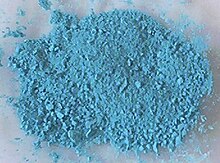Basic copper carbonate
| Structural formula | ||||||||||||||||
|---|---|---|---|---|---|---|---|---|---|---|---|---|---|---|---|---|
 |
||||||||||||||||
| General | ||||||||||||||||
| Surname | Basic copper carbonate | |||||||||||||||
| other names |
|
|||||||||||||||
| Molecular formula | CuCO 3 · Cu (OH) 2 | |||||||||||||||
| Brief description |
light green odorless solid |
|||||||||||||||
| External identifiers / databases | ||||||||||||||||
|
||||||||||||||||
| properties | ||||||||||||||||
| Molar mass | 221.20 g mol −1 | |||||||||||||||
| Physical state |
firmly |
|||||||||||||||
| density |
4.0 g cm −3 |
|||||||||||||||
| Melting point |
200 ° C (decomposition) |
|||||||||||||||
| solubility |
practically insoluble in water |
|||||||||||||||
| safety instructions | ||||||||||||||||
|
||||||||||||||||
| MAK |
0.1 mg m −3 |
|||||||||||||||
| Toxicological data | ||||||||||||||||
| As far as possible and customary, SI units are used. Unless otherwise noted, the data given apply to standard conditions . | ||||||||||||||||
Basic copper carbonate is a copper salt of carbonic acid . The pure copper (II) carbonate compound (CuCO 3 ) could not yet be represented. All previously known carbonate compounds of copper (II) are basic compounds such as the copper minerals listed under Occurrence . Metallic copper surfaces are first oxidized in the atmosphere to copper (I) oxide (Cu 2 O) and then converted into green basic copper (II) carbonate, the patina , with further oxidation by the CO 2 in the air . However, the latter is rarely a pure basic carbonate and often contains other anions such as sulfate and / or chloride .
Occurrence
Naturally occurring minerals of basic copper (II) carbonates are malachite (CuCO 3 · Cu (OH) 2 ) and azurite (also called copper glaze) (2 CuCO 3 · Cu (OH) 2 ).
Extraction and presentation
If a copper (II) salt solution is mixed with an alkali metal carbonate solution in the laboratory, either a blue or a green precipitate of basic copper (II) carbonate forms, depending on the excess of sodium carbonate. Both basic copper (II) carbonates are insoluble in water and are precipitated and can be filtered off.
The deep blue carbonate is the pigment 2 CuCO 3 · Cu (OH) 2 , which occurs naturally as azurite mineral. The production of this pigment is described in Gmelin. The equation for this reaction is:
When exposed to light, the deep blue carbonate slowly disintegrates into green malachite (CuCO 3 · Cu (OH) 2 ), a more basic pigment.
The equation for the overall reaction to malachite is therefore as follows:
properties
Anhydrous copper (II) carbonate is an odorless light blue powder, the monohydrate is dark green. It is insoluble in water and decomposes from 140 ° C to copper (II) oxide and carbon dioxide :
The reaction with acids produces carbon dioxide and the copper salt of the acid:
use
Copper (II) carbonate is used in the production of many copper compounds , such as copper sulfate , CuSO 4 and copper (II) oxide , CuO .
Individual evidence
- ↑ a b c d e f g h Entry on copper (II) hydroxide carbonate in the GESTIS substance database of the IFA , accessed on December 29, 2019(JavaScript required) .
- ↑ Entry on Copper (II) carbonate - copper (II) hydroxide (1: 1) in the Classification and Labeling Inventory of the European Chemicals Agency (ECHA), accessed on December 29, 2019. Manufacturers or distributors can expand the harmonized classification and labeling .
- ^ AF Holleman , E. Wiberg : Textbook of Inorganic Chemistry . 37-39 Edition. Walter de Gruyter, Berlin 1956, p. 450.
- ↑ Gmelin Institute for Inorganic Chemistry and Frontier Areas in the Max Planck Society. Gmelin's Handbook of Inorganic Chemistry , System Number 60: Copper, Part B, Delivery 2nd Weinheim / Bergstrasse, 8th Edition, 1961. P. 652.











